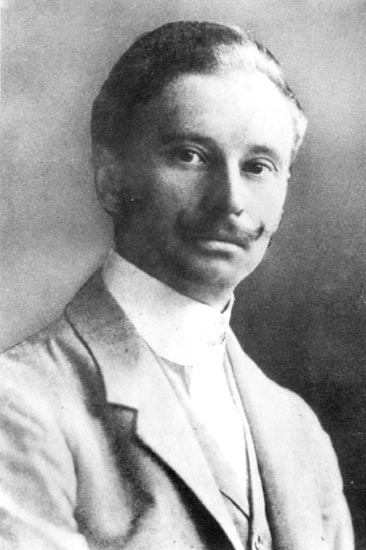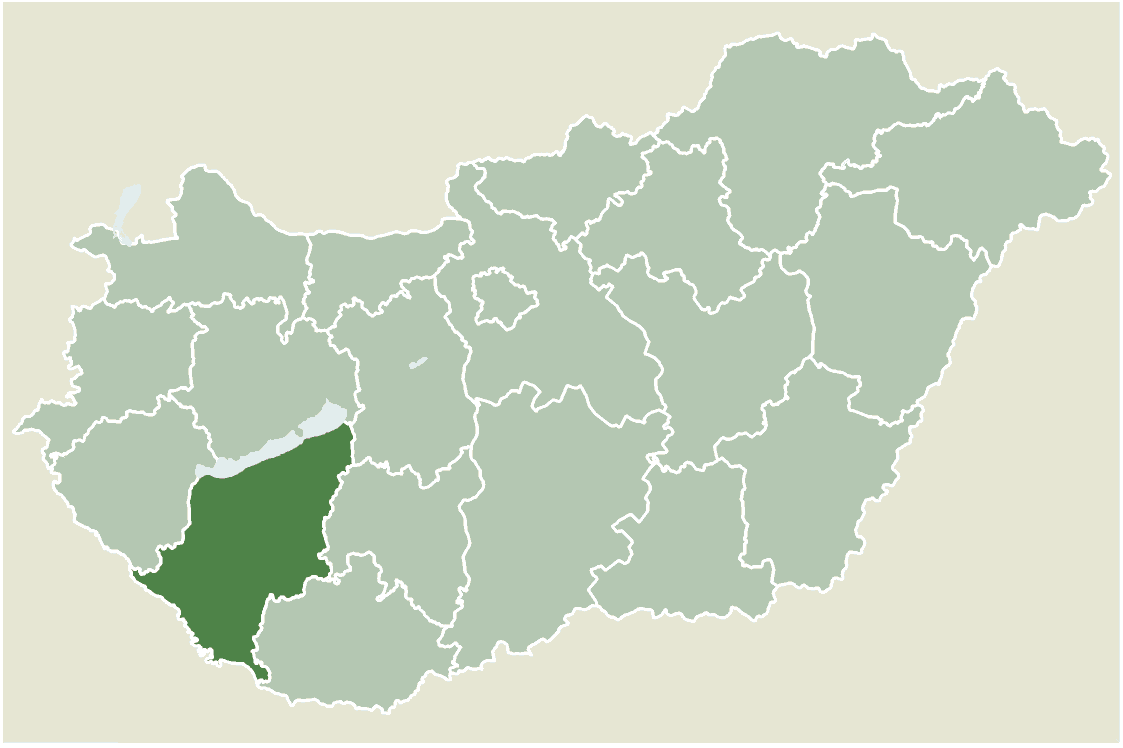|
Ede Magyar
Ede Magyar (Ede Oszadszki) (Orosháza, 31 January 1877 – Szeged, 5 May 1912) was an architect, nicknamed 'the Hungarian Gaudi' for his similar organic style. Life and career The son of Mihály Oszadszki, a cabinet maker, Magyar was three years old when the family changed its name. He became a master builder after studying in Budapest in 1901, and completed further studies abroad. His short but notable career focused on Szeged where he designed the Reök Palace (1907) and numerous other organic buildings. He was only 35 when he committed suicide following disappointment in love. He was buried in Dugonics cemetery where there is a permanent memorial to him tended by the city council since 2004. Works *Szeged: Burghardt House (Cafe Wien); Schaffer House (1904); Reök Palace (1907); Unger-Mayer House (1911), Reformed Palace *Senta, Zenta: Rottmann House (1910); Royal Hotel (1911) *Kaposvár Theatre (1911) with József Stahl *Hódmezővásárhely: Simon Palace (1910) * Ge ... [...More Info...] [...Related Items...] OR: [Wikipedia] [Google] [Baidu] |
Hódmezővásárhely
Hódmezővásárhely (; also known by other alternative names) is a city with county rights in southeast Hungary, on the Great Hungarian Plain, at the meeting point of the Békés-Csanádi Ridge and the clay grassland surrounding the river Tisza. In 2017, it had a population of 44,009. Etymology and names The city's name, which literally translates as ''Beavers' Field Marketplace'', was first mentioned after the unification of two Árpád-era villages, Hód and Vásárhely, the former getting its name from Beaver's lake, an apocope of ''Hód-tó'' (now one of the city's districts and the canal ''Hód-tavi-csatorna)'' and the latter coming from the mediaeval legal term marking settlements with the right of hosting markets and literally meaning market town. The middle term ''mező'', which also refers to the city's state as an ''oppidum'', a city with certain rights that are given by its feudal ruler, was later added to the town and to its name. The city is also known by alterna ... [...More Info...] [...Related Items...] OR: [Wikipedia] [Google] [Baidu] |
Art Nouveau Architects
Art is a diverse range of cultural activity centered around ''works'' utilizing creative or imaginative talents, which are expected to evoke a worthwhile experience, generally through an expression of emotional power, conceptual ideas, technical proficiency, or beauty. There is no generally agreed definition of what constitutes ''art'', and its interpretation has varied greatly throughout history and across cultures. In the Western tradition, the three classical branches of visual art are painting, sculpture, and architecture. Theatre, dance, and other performing arts, as well as literature, music, film and other media such as interactive media, are included in a broader definition of "the arts". Until the 17th century, ''art'' referred to any skill or mastery and was not differentiated from crafts or sciences. In modern usage after the 17th century, where aesthetic considerations are paramount, the fine arts are separated and distinguished from acquired skills in general, ... [...More Info...] [...Related Items...] OR: [Wikipedia] [Google] [Baidu] |
Hungarian Architects
Hungarian may refer to: * Hungary, a country in Central Europe * Kingdom of Hungary, state of Hungary, existing between 1000 and 1946 * Hungarians/Magyars, ethnic groups in Hungary * Hungarian algorithm, a polynomial time algorithm for solving the assignment problem * Hungarian language, a Uralic language spoken in Hungary and all neighbouring countries * Hungarian notation, a naming convention in computer programming * Hungarian cuisine Hungarian or Magyar cuisine (Hungarian language, Hungarian: ''Magyar konyha'') is the cuisine characteristic of the nation of Hungary, and its primary ethnic group, the Hungarians, Magyars. Hungarian cuisine has been described as being the P ..., the cuisine of Hungary and the Hungarians See also * * {{disambiguation Language and nationality disambiguation pages ... [...More Info...] [...Related Items...] OR: [Wikipedia] [Google] [Baidu] |
1912 Deaths
This year is notable for Sinking of the Titanic, the sinking of the ''Titanic'', which occurred on April 15. In Albania, this leap year runs with only 353 days as the country achieved switching from the Julian to Gregorian Calendar by skipping 13 days. Friday, 30 November ''(Julian Calendar)'' immediately turned Saturday, 14 December 1912 ''(in the Gregorian Calendar)''. Events January * January 1 – The Republic of China (1912–49), Republic of China is established. * January 5 – The Prague Conference (6th All-Russian Conference of the Russian Social Democratic Labour Party) opens. * January 6 ** German Geophysics, geophysicist Alfred Wegener first presents his theory of continental drift. ** New Mexico becomes the 47th U.S. state. * January 8 – The African National Congress is founded as the South African Native National Congress, at the Waaihoek Wesleyan Church in Bloemfontein, to promote improved rights for Black people, black South Africans, with Joh ... [...More Info...] [...Related Items...] OR: [Wikipedia] [Google] [Baidu] |
1877 Births
Events January * January 1 – Queen Victoria is proclaimed Empress of India by the Royal Titles Act 1876, introduced by Benjamin Disraeli, the Prime Minister of the United Kingdom . * January 8 – Great Sioux War of 1876: Battle of Wolf Mountain – Crazy Horse and his warriors fight their last battle with the United States Cavalry in Montana. * January 20 – The Conference of Constantinople ends, with Ottoman Turkey rejecting proposals of internal reform and Balkan provisions. * January 29 – The Satsuma Rebellion, a revolt of disaffected samurai in Japan, breaks out against the new imperial government; it lasts until September, when it is crushed by a professionally led army of draftees. February * February 17 – Major General Charles George Gordon of the British Army is appointed Governor-General of the Sudan. March * March 2 – Compromise of 1877: The 1876 United States presidential election is resolved with the selection of Ru ... [...More Info...] [...Related Items...] OR: [Wikipedia] [Google] [Baidu] |
Gergely Csiky Theatre
The Gergely Csiky Theatre is a theatre in Kaposvár, Hungary. Opening in 1911, the theatre became a major cultural center in Somogy County, with its company achieving their greatest successes between 1970–1985. The building Designed by the well-known Ede Magyar and József Stahl, and named after 19th century dramatist Gregor Csiky, the theatre was opened in 1911 in the former Búza square of Kaposvár, as the city's first theatre. With its unique semi-cylindrical sides and distinct roofing it is regarded as an outstanding architectural achievement of its time. It was originally planned with a capacity of 1400, but with modifications, this number shrank to 860. Despite this, the theatre is one of the major such institutions in the country. The structure was Hungary's first to utilize ferro-concrete roofing. It saw two major renovations, first in the fifties, extending the stage area, and another during the eighties, this time fully renewing the building, and upgrading its tech ... [...More Info...] [...Related Items...] OR: [Wikipedia] [Google] [Baidu] |
Kaposvár
Kaposvár (; also known by alternative names) is a city with county rights in southwestern Hungary, south of Lake Balaton. It is one of the leading cities of Transdanubia, the capital of Somogy County, and the seat of the Kaposvár District and the Roman Catholic Diocese of Kaposvár. Etymology and names The name ''Kaposvár'' is derived from the Hungarian words ''kapu'' (gate) and ''vár'' (castle). Variants of the city's name include ''Ruppertsburg'' / ''Ruppertsberg'' / ''Kopisch'' ( German), ''Kapoşvar'' ( Turkish), ''Rupertgrad'' ( Slovene), and ''Kapošvar'' ( Croatian). Symbols The shield of Kaposvár features a castle with a rounded arch port surmounted by three battlements with loopholes on a hill of green grass. The flag of Kaposvár consists of the coat of arms placed over a yellow background. Geography Kaposvár is surrounded by the hills of the outer Somogy area around the Kapos river and the forests of Zselic. It lies southwest of Budapest. Historica ... [...More Info...] [...Related Items...] OR: [Wikipedia] [Google] [Baidu] |
Orosháza
Orosháza is a city situated in the westernmost part of Békés (county), Békés county, Hungary, on the Békés ridge bordered by the rivers River Maros, Maros and River Körös, Körös. Orosháza is an important culture, cultural, educational and recreational centre of the region. Main sights The city's main attractions are the Orosháza-Gyopárosfürdő spa complex, the Szántó Kovács János Museum, the Darvas József Literary Memorial House, and the Town Art Gallery. The only museum in the country devoted to water wells is found in Orosháza. At the Rágyánszky Arboretum, more than 2000 plant species in 6000 varieties can be seen. The Lutheran church, was built between 1777 and 1830 in late Baroque style. It is located in the centre of the town. The bell carried by the first settlers, who migrated from Zomba, Hungary, Zomba, is kept in front of the altar of the church. A number of cultural and entertaining programmes are organised in the town every year. Notable re ... [...More Info...] [...Related Items...] OR: [Wikipedia] [Google] [Baidu] |
Senta
Senta ( sr-cyrl, Сента, ; Hungarian language, Hungarian: ''Zenta'', ; Romanian language, Romanian: ''Zenta'') is a town and municipality located in Vojvodina, Serbia. It is situated on the bank of the Tisza, Tisa river in the geographical region of Bačka. The town has a population of 14,452, whilst the Senta municipality has 17,953 inhabitants (2022 census). History Archaeological finds indicate that the area around the modern settlement was populated from the prehistoric times. Neolithic and eneolithic societies settled in the vicinity of modern Senta thousands of years ago leaving credible traces of their presence. A Neolithic Tiszapolgár–Bodrogkeresztúr culture necropolis was found in Senta. The first historic population that might have lived in the area were most likely the Agathyrsi (6th century BC). With certainty we can claim that the inhabitants of the early "Senta" in the 6th century AD were Sarmatians, Slavs alike and Pannonian Avars, Avars. Hungarian peopl ... [...More Info...] [...Related Items...] OR: [Wikipedia] [Google] [Baidu] |





